Introduction
Grasping the fundamental concepts of configuration management is crucial for maintaining systems in a consistent state. Configuration management (CM) involves keeping computer systems, servers, and software in a desired and reliable state, often through automation. It integrates people, tools, and processes to oversee the application from inception to retirement, ensuring that each phase meets the organization's standards and requirements.
Software configuration management (SCM), a subset of CM, focuses on controlling the evolution of software artifacts throughout the development and release lifecycle. SCM enables tracking of changes and maintaining the integrity of products. Implementing these practices leads to improved speed, scale, and stability.
In the context of DevOps, selecting the right configuration management tools is paramount. An effective tool offers an intuitive interface and robust support to effortlessly manage the desired state of the infrastructure. SCM's role is to provide visibility and manage changes in a controlled manner, which is essential for sustaining the performance and functional integrity of the product.
By establishing functional and physical baselines as reference points, SCM ensures the essence of the product remains intact. Embracing SCM and DevOps methodologies leads to increased software quality and customer satisfaction. In summary, configuration management is a strategic exercise that integrates various aspects of the software development lifecycle and quality management to maintain reliable and high-quality software solutions.
Key Concepts in Configuration Management
Grasping the fundamental concepts of configuration management is crucial for maintaining systems in a consistent state. At its core, configuration management (CM) is about keeping computer systems, servers, and software in a desired and reliable state, often through automation. Application lifecycle management (ALM) integrates people, tools, and processes to oversee the application from inception to retirement, ensuring that each phase meets the standards and requirements set forth by the organization. To elaborate, software configuration management (SCM), a subset of CM, focuses on controlling the evolution of software artifacts, from source code to libraries, throughout the development and release lifecycle. SCM enables tracking of changes by identifying unique versions of these artifacts as configuration items (CIs) and supports maintaining the integrity of products. The discipline is integral to software quality assurance, facilitating change control, enabling parallel development, and ensuring that releases can be recreated if necessary. Implementing these practices leads to improved speed, scale, and stability across an organization. In the context of DevOps, selecting the right configuration management tools is paramount. These should not only be aligned with the team's budget and licensing requirements but also support infrastructure as code. An effective tool will offer an intuitive interface and robust support to effortlessly manage the desired state of the infrastructure, as seen with Puppet's declarative language, which specifies the 'what' without detailing the 'how.' As highlighted by the Software Engineer Book of Knowledge (SWEBOK), SCM's role is to provide visibility and manage changes in a controlled manner, which is essential for sustaining the performance and functional integrity of the product. According to SCM best practices, establishing functional and physical baselines as reference points is crucial, akin to maintaining the essence of Theseus' ship, even as its parts are replaced over time.
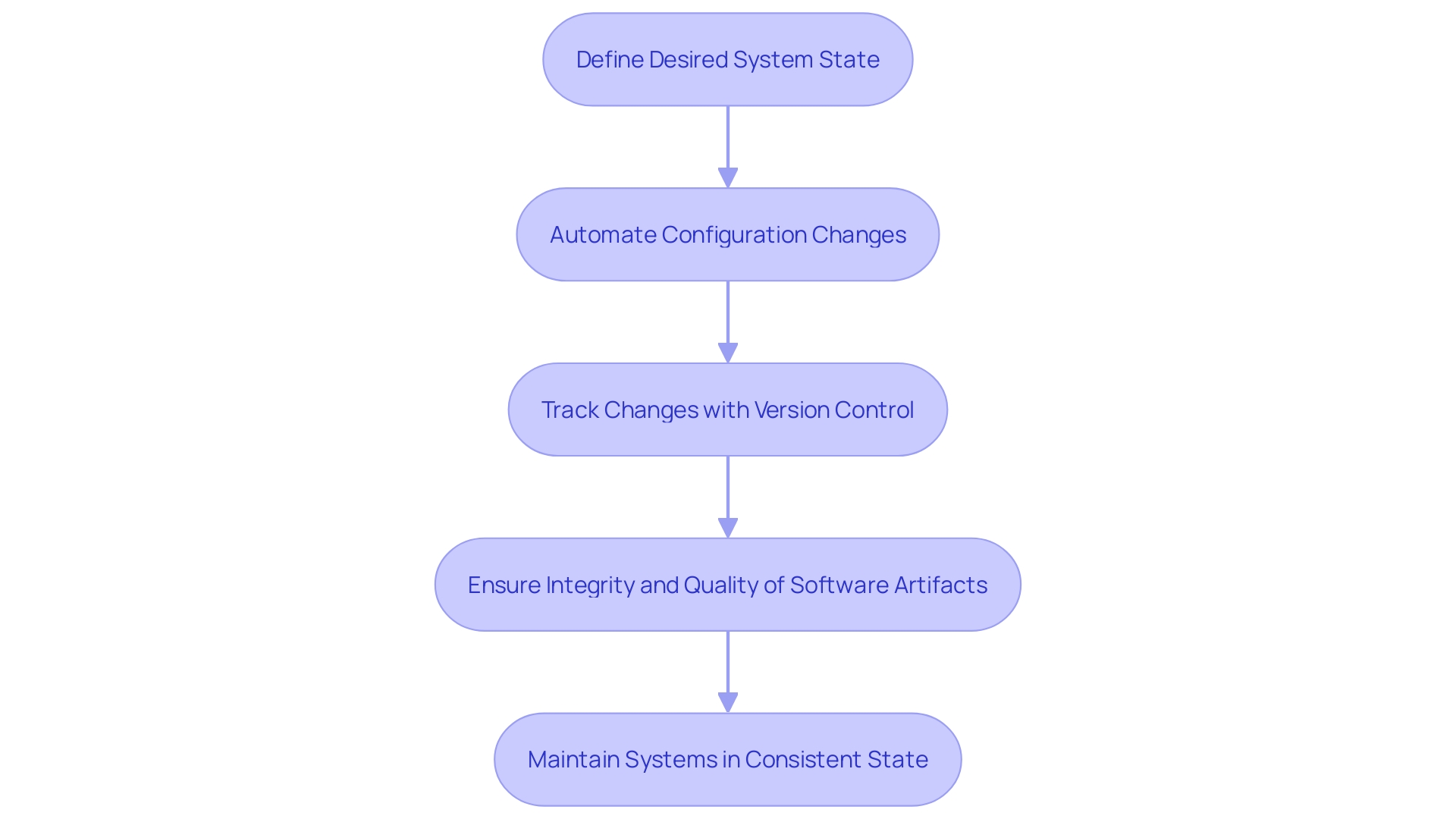
Benefits of Configuration Management
The discipline of Software Configuration Management (SCM) is essential for maintaining the integrity and traceability of software products throughout their lifecycle. SCM carefully manages changes to software artifacts, providing a clear history of their evolution from source code and libraries to final product releases. This meticulous approach ensures that each unique version of software artifacts, designated as configuration items (CIs), is accurately recorded and that the development process, including parallel development, maintains a controlled and efficient workflow.
By embracing SCM, developers benefit from established procedures for change control and are supported in the recreation of releases, which is particularly crucial for maintaining high-quality software applications. The attributes of functionality, reliability, usability, and efficiency are all significantly enhanced, leading to overall performance improvements and heightened user satisfaction.
Furthermore, the Agile software development methodology complements SCM by promoting collaboration between developers and business executives, adapting to changes even in late project stages, and embracing rapid iterations for faster delivery. Contrastingly, the more traditional waterfall approach, with its emphasis on extensive upfront planning, is being challenged by Agile's flexibility and responsiveness to change.
The implementation of SCM, while involving upfront costs, is considered a valuable investment for long-term gains, as observed in a comprehensive study at Ericsson. The study reported that despite the initial efforts required for compliance and integration, the payoff included improved quality, productivity, customer experience, and working methods. DevOps, a methodology that integrates software development with IT operations, further augments SCM by enhancing communication and teamwork, leading to better overall performance, customer satisfaction, and faster time-to-market.
As highlighted by recent industry research, continuous integration (CI) and other best practices in SCM are being linked to an increase in software quality, showcasing the measurable benefits of these methodologies. By integrating SCM and DevOps into modern software development processes, organizations are better equipped to tackle the dynamic challenges of the industry, ensuring timely, high-quality solutions that meet the ever-growing demands of the competitive marketplace.
Steps in Implementing Configuration Management
Setting up an effective configuration management (CM) system is a complex but essential task that involves coordinating resources, systems, people, and environments to enhance speed, scalability, and stability throughout an organization. Configuration management ensures that computer systems, servers, and software maintain a desired, consistent state, often through automation. It is a fundamental part of IT management, aligning closely with Application Lifecycle Management (ALM), which manages the life cycle of an application from conception to decommissioning, and with the concept of a Standard Operating Environment (SOE) to standardize builds across the organization.
The Software Engineer Book of Knowledge (SWEBOK) defines Software Configuration Management (SCM) as a discipline for managing changes to software artifacts across the development life cycle and product releases, providing visibility into software configurations at any point, and handling changes in a controlled manner. SCM process ensures the integrity of products by maintaining how they are constructed from source code, libraries, and other components. It tracks changes to these artifacts, identified as configuration items (CIs), over time.
According to SWEBOK, SCM is integral to software quality assurance, release management, and adhering to engineering best practices. It allows for the establishment of standard practices for change control, supports parallel development, and facilitates the recreation of releases. These practices are vital for maintaining the quality of software applications, which is multifaceted and critical to the success of any development project. Quality attributes such as functionality, reliability, usability, and efficiency are central to performance and user satisfaction.
A study investigating the causal relationships between continuous integration (CI) and software quality underscores the importance of SCM. CI, a practice that integrates code frequently to reduce costs and risks, is shown to improve testing, enhance quality assurance, and reduce issue reports. This highlights the need for a robust SCM process as part of modern software development, which includes phases like requirements analysis, design, implementation, testing, and deployment.
By considering the multi-dimensional aspects of software quality and the cyclical nature of the software development process, SCM becomes a crucial tool for ensuring that each software release is reliable, functional, and meets user expectations. Implementing SCM requires not only the selection of appropriate tools but also a comprehensive strategy that encompasses the management of changes, the integrity of products, and the facilitation of team collaboration. Theory W emphasizes this need for a collaborative approach, suggesting that project managers will only be successful if they create win-win situations for all stakeholders, including developers, customers, and users.
In summary, the process of setting up configuration management is a strategic exercise that integrates various aspects of the software development lifecycle and quality management. It involves a detailed understanding of both the technical and managerial facets, ensuring that software artifacts are controlled, the integrity of products is maintained, and that every release meets the established quality standards.
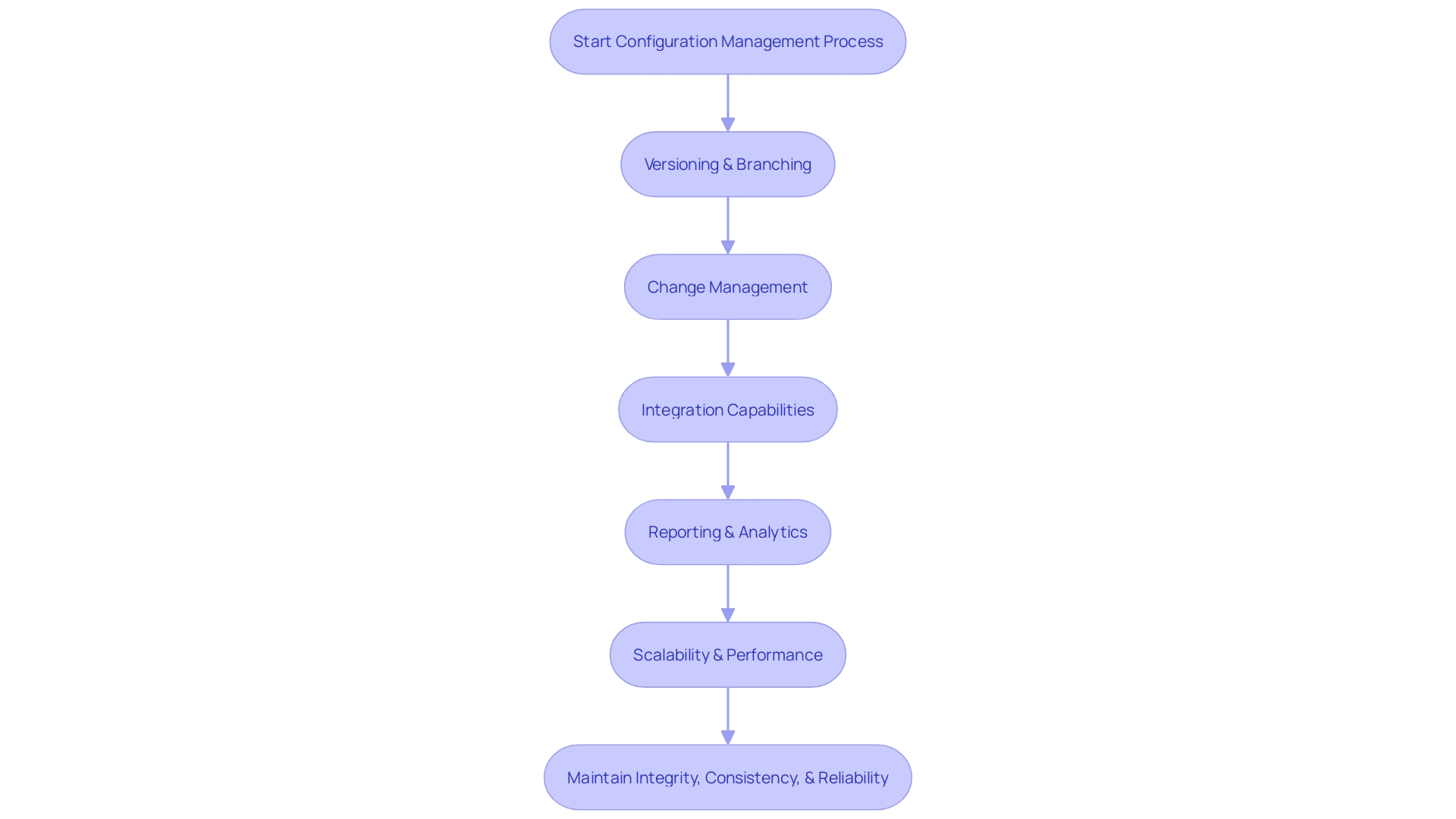
Identification and Baseline Configuration
Establishing a baseline configuration is a cornerstone in managing a project's technical scope and ensuring successful software development. It involves identifying the necessary configuration items and defining a stable foundation from which the project can evolve. This process is crucial because it not only outlines the project's objectives and deliverables but also provides a reference point for future project activities and maintenance.
Configuration items encompass a variety of elements, such as the scope statement, which summarizes the project's characteristics, objectives, and deliverables; the Work Breakdown Structure (WBS), breaking down the project into smaller, manageable milestones; and the WBS Dictionary, offering detailed activities and deliverables. Additionally, it includes the project's approved budget and timeline, which comprises start and end dates, assigned roles, and initial estimates that guide the project towards completion within budgetary constraints.
The importance of a well-defined baseline configuration cannot be overstated. Studies have shown that approximately 33% of projects fail globally due to factors like inaccurate requirements or shifting project goals. A solid baseline acts as a guardrail against such pitfalls by providing a clear and consistent reference for all stakeholders. As the software industry evolves, with start-ups and government projects posing unique challenges, the baseline must adapt to accommodate various aspects such as data visualization needs, stakeholder policies, and the influence of culture and policy on team dynamics.
Experts in the field emphasize the significance of creating 'win conditions' for all participants in the software process, from managers and customers to users and maintainers. This approach, known as Theory W, advocates for managers to act as negotiators and solution packages, ensuring that every stakeholder's interests are represented and aligned. The success of this philosophy has been demonstrated through case studies, such as the introduction of new information systems in emerging nations, underscoring the impact of a collaborative and inclusive project management style.
Moreover, the vernacular used within a team or organization serves as a shorthand for complex processes, saving time and fostering a shared understanding among team members. The terms and phrases unique to a team's language encapsulate broader concepts and facilitate efficient communication.
Incorporating lessons from empirical studies and industry experiences into the establishment of a baseline configuration is instrumental. It enables software organizations to navigate the intricacies of maintenance and enhancement during the software lifecycle, ultimately contributing to the effective management and success of software projects. With the right approach, organizations can mitigate risks, protect their reputation, and gain entry into regulated markets, all while achieving the ultimate goal of delivering high-quality software that meets the evolving needs of users and stakeholders.
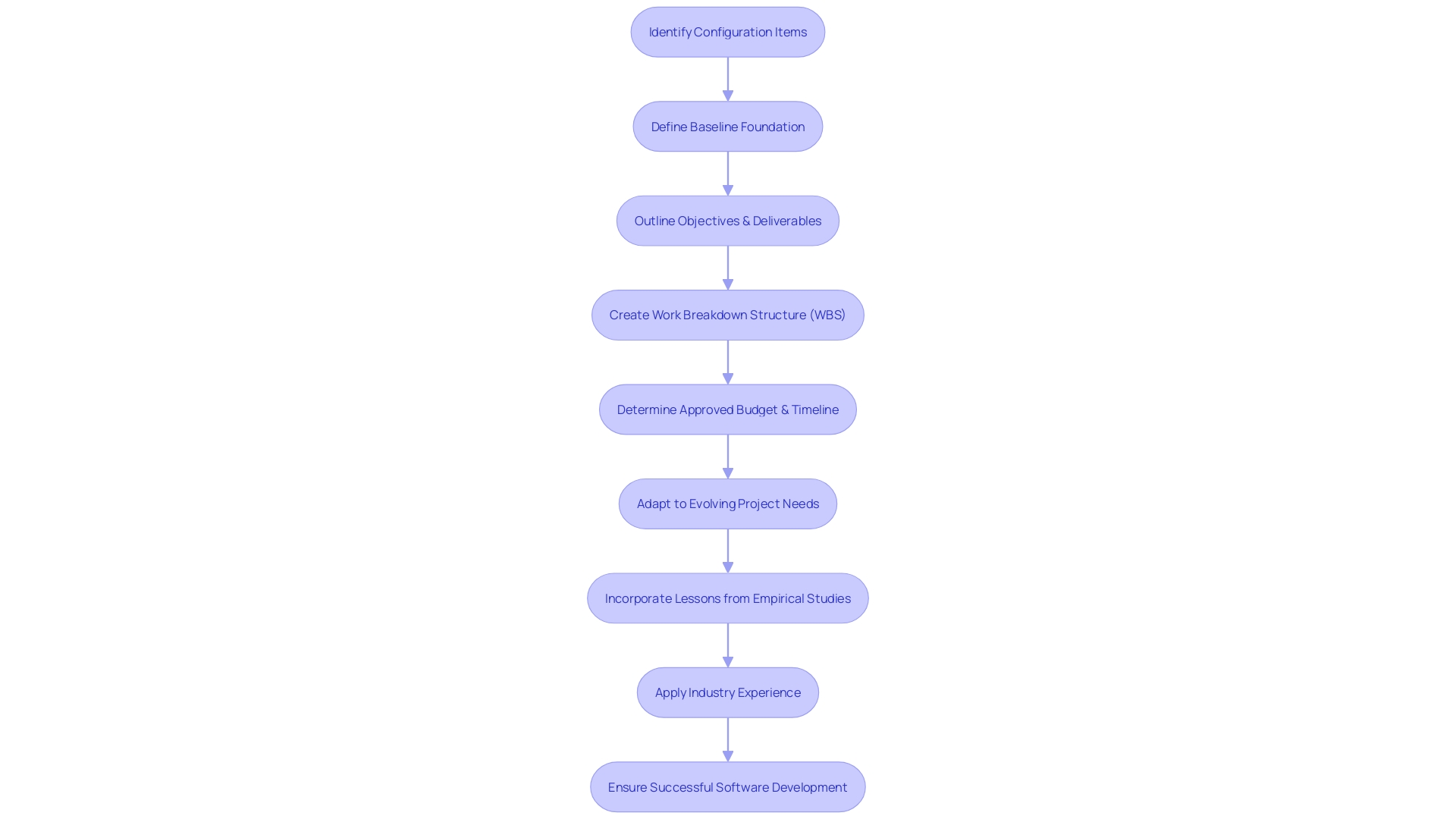
Version Control and Auditing
Effective configuration management is crucial for ensuring that computer systems, servers, and software maintain their intended, consistent states. It is a systematic process that not only supports the maintenance of system integrity over its life cycle but also optimizes the management of software changes. A core aspect of configuration management is software configuration management (SCM), which focuses on the discipline of tracking and controlling changes in the software, part of the larger cross-disciplinary field of application lifecycle management (ALM).
SCM practices provide a structured approach to managing software artifacts throughout their development and release cycles. This includes identifying unique versions of software components, known as configuration items (CIs), and meticulously monitoring their evolution. By establishing baselines and employing change control techniques, SCM ensures that any progression in the software can be traced back to its source, thereby maintaining the integrity of the product.
The significance of SCM is highlighted by the fact that the majority of modern applications are built with an extensive use of open source components. According to the 2024 Open Source Security and Risk Analysis (OSSRA) report, 96% of the commercial software analyzed contained open source, with an average of 526 open source components per application. This staggering number underscores the need for an automated approach to security testing, rendering manual methods impractical. Software composition analysis (SCA) is one such automated solution that has become indispensable for managing the complexities of open source usage.
In addition to SCM, the deployment of Continuous Integration and Continuous Deployment (CI/CD) servers like TeamCity from JetBrains, which is utilized by over 30,000 customers globally, plays a pivotal role in automating the software development processes. These CI/CD servers are not only responsible for compiling and deploying code but also safeguard sensitive information like keys and build artifacts. However, as recent insights reveal, over 3,000 on-premises TeamCity servers are exposed to the internet, thus presenting a high-value target for attackers. Such vulnerabilities underline the critical necessity of robust version control and auditing systems to safeguard valuable assets like source code.
By adopting standard version control systems and auditing practices, organizations can ensure that they establish and track functional and physical attributes of their products effectively. This traceability is vital for performance, as it allows teams to revisit previous versions of source code, facilitating troubleshooting, comprehension, and reverting to stable builds when necessary.
Ultimately, the goal of version control and auditing in configuration management is to preserve the functional and physical integrity of software products, akin to the preservation of Theseus' ship, where each change is meticulously recorded and managed to maintain the identity and performance of the 'ship' through its journey in the software lifecycle.
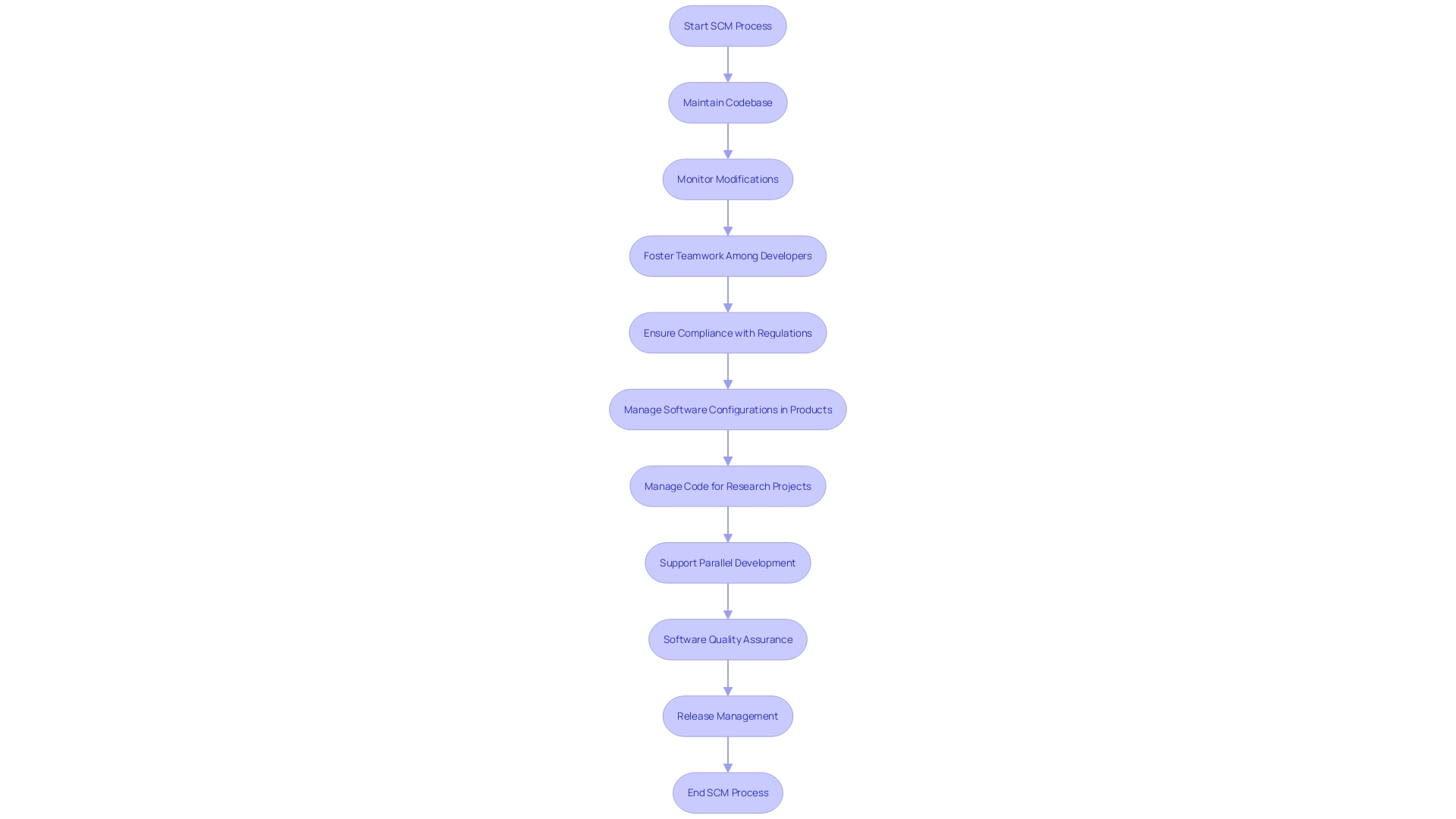
Popular Configuration Management Tools
The landscape of configuration management tools is both vast and dynamic, catering to a range of automation and performance needs. Let's delve into some of the most widely adopted tools in the industry, focusing on their capabilities, application scenarios, and the value they add to IT operations.
Ansible stands out for its simplicity and ease of use. Installation is straightforward, particularly on Unix-based systems, and its comprehensive official guide assists with setup on other platforms. With Ansible, IT professionals can craft Playbooks to automate repetitive tasks, saving time and resources that can be redirected towards more strategic initiatives. The Ansible Automation Platform elevates this further by enhancing security and enabling the extensive automation of complex IT environments, including Linux and Windows servers, networking devices, and various cloud services.
Chef is another powerful contender, particularly suited for experienced programmers who require a tool capable of managing intricate tasks. It shines in its support for infrastructure as code, enabling teams to automate the configuration of machines with precision. Its intuitive interface aligns well with the needs of DevOps, providing an effective solution for project managers and developers alike.
Puppet has been a mainstay in the configuration management domain, offering a mature solution for automating across diverse infrastructures. It's known for its scalability and the ability to enforce desired system states, making it a reliable choice for ensuring compliance and consistency across large deployments.
SaltStack, now known as Salt Project, brings a unique approach with its event-driven automation capabilities. It facilitates efficient management and configuration of data centers at scale, and the recent updates to its quickstart tutorial demonstrate an ongoing commitment to community engagement and user support.
The integration of these tools into DevOps practices has led to significant shifts in software development and operations. They contribute to a reduction in overhead and faster times to market by automating key stages of the software development lifecycle. This ecosystem of tools also helps bridge the gap between development, operation, and quality assurance, fostering better collaboration and continuous improvement.
As the field of software development continues to evolve rapidly, these tools provide developers, system administrators, and IT professionals with the means to not only keep pace but also drive innovation and operational effectiveness.
Git and Version Control
Version control systems (VCS) like Git are indispensable in the realm of software development, serving as the backbone for managing changes to codebases, tracking version history, and facilitating collaboration among developers. Git, in particular, has evolved to support a variety of functions beyond mere version control, positioning itself as a formidable tool for configuration management—essentially the art of maintaining a consistent and functional software environment throughout its lifecycle.
According to the Software Engineer Book of Knowledge (SWEBOK), software configuration management (SCM) encompasses the controlled changes and tracking of software artifacts from inception through to release. Using Git for SCM involves leveraging its powerful features to maintain the integrity of software products, manage changes in a controlled manner, and provide visibility into the configuration at any given point. It allows teams to identify unique versions of software artifacts, known as configuration items (CIs), and to track their evolution. Moreover, Git's robust branching and merging capabilities support parallel development, enabling teams to work concurrently without stepping on each other's toes, thus reducing defects and avoiding unauthorized changes that may introduce inconsistencies.
Contemporary discourse around Git, as evidenced by recent talks and conferences, reveals that many developers are unaware of its advanced features that have emerged over the years. For instance, the recent release of Fitness, an open-source platform that integrates source code management with automated CI pipelines, showcases the ongoing innovation in this space. This platform aims to streamline software development workflows by reducing the need to manage multiple tools, thereby enhancing collaboration and security.
The demand for proficient version control systems is underscored by industry analysts, such as Christopher Condo from Forrester Research, who notes the direct correlation between the growing need for software in various domains, including infrastructure as code and low-code platforms, and the demand for robust version control. This demand is echoed in the findings of the 2024 Docker State of Application Development Report, which reflects the shifting landscape of application development, the rise of microservices, and shifts toward security-conscious development practices.
Configuration management, when done effectively, ensures that software can withstand the test of time and remain buildable and maintainable, a concern that has become more pronounced as software projects increase in complexity. By utilizing tools like Git for SCM, organizations can mitigate risks associated with change and maintain the high performance and reliability of their software systems.
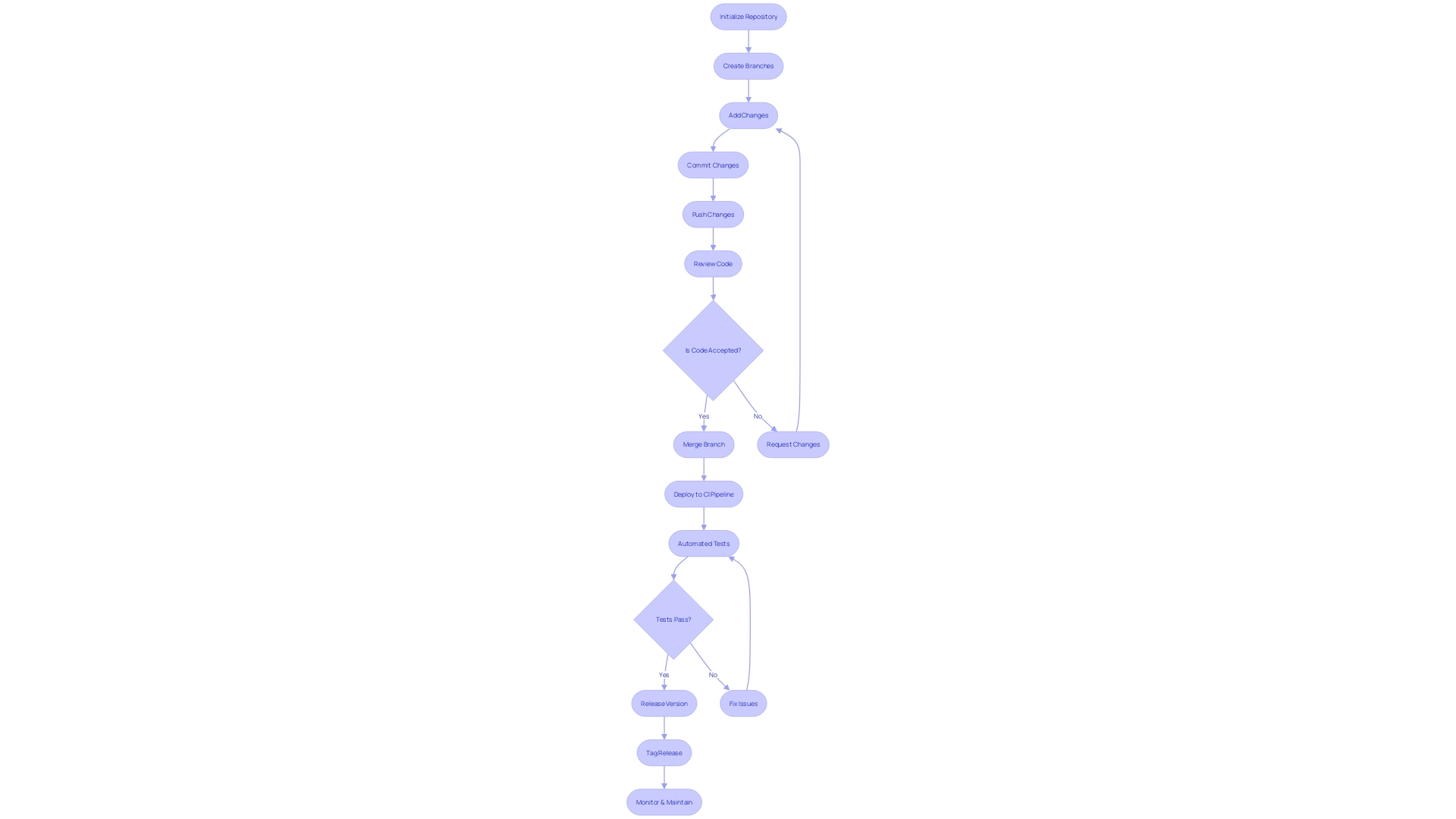
Docker and Containerization
Docker, a leading containerization platform, has become synonymous with modern software deployment, offering a streamlined approach to managing software configurations. By creating isolated environments known as containers, Docker enables developers to package applications with their necessary libraries, dependencies, and configuration files, which simplifies development and deployment across diverse environments. This is particularly advantageous for firms like JaneTech that develop bespoke technology solutions across various industries, ensuring consistency and performance regardless of the project's nature.
With the rise of containerization, understanding Docker's core components is crucial. Docker images serve as immutable templates for containers, including everything required to run an application. When an image is instantiated, it becomes a Docker container, providing a consistent and isolated runtime environment. The use of Dockerfiles, scripts containing commands to build images, further automates and standardizes the deployment process.
The insights from the 2024 Docker State of Application Development Report, based on responses from over 1,300 participants, highlight the continued growth and relevance of Docker in the software development landscape. The report underscores the role of Docker in addressing common developer frustrations and enhancing processes. As noted by Nahid Samsami, Vice President of Developer Experience at Docker, the platform is dedicated to empowering developers with the right tools for their workflows, reinforcing the importance of Docker in the evolving world of software development.
Infrastructure as Code (IaC) practices, which rely on scripts for automating infrastructure management, complement Docker's capabilities. IAC ensures infrastructure consistency and reduces the risk of human error, which aligns with container technology's promise of reproducibility and stability. This synergy between containerization and IAC can be particularly beneficial for IT management, helping to streamline application lifecycle management and maintain a standard operating environment.
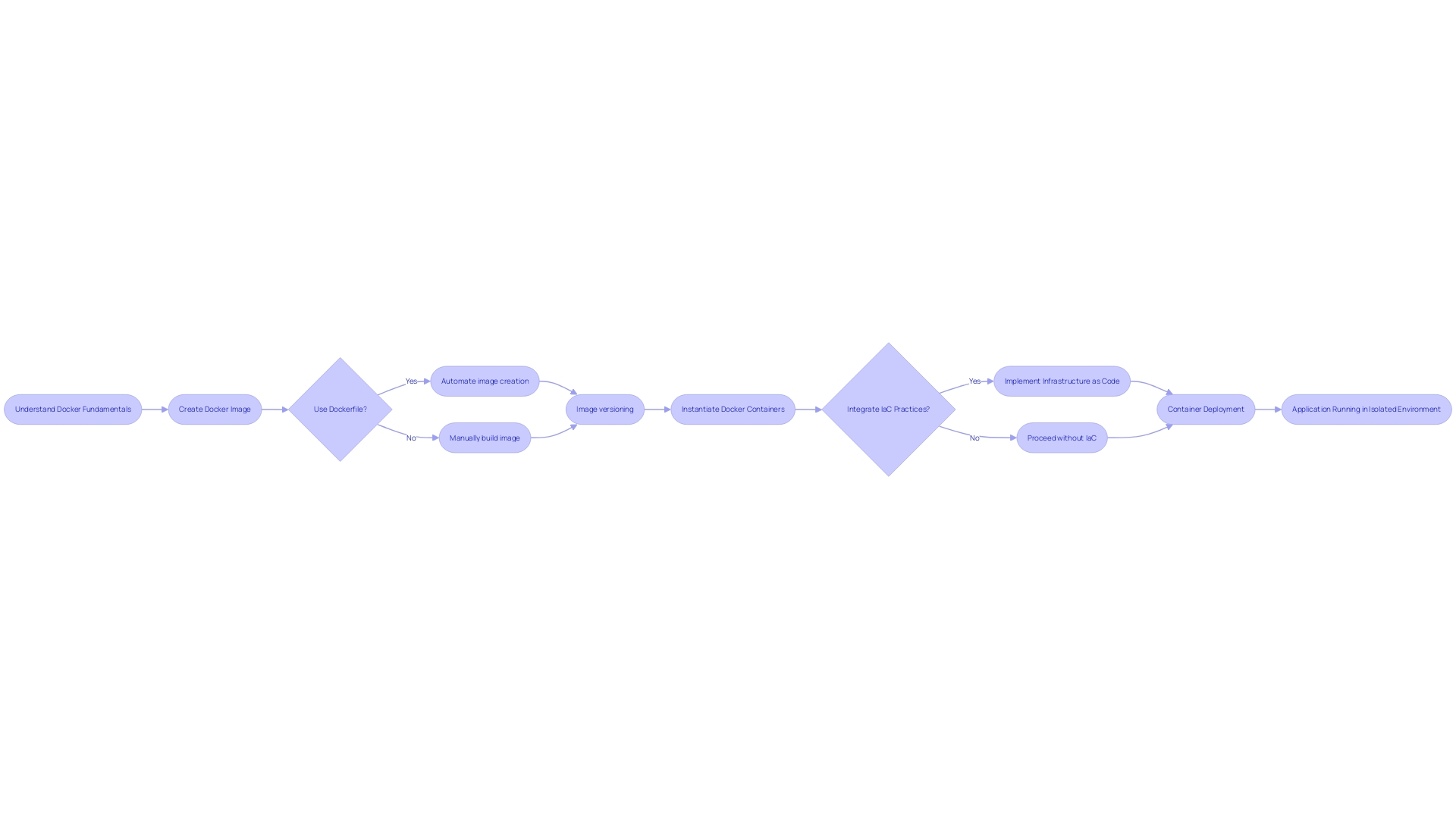
Terraform and Infrastructure as Code
Terraform, recognized for its versatility in infrastructure management, stands at the forefront of Infrastructure as Code (IAC) tools. It's designed to streamline the provisioning and management of infrastructure through a declarative approach, using human-readable configuration files that can be versioned, shared, and reused. This results in an automated and efficient way to manage IT resources, catering to the evolving needs of businesses and technology landscapes.
As a case in point, a company's evolution in 2017 marked a significant shift toward efficient infrastructure management. The need to move away from manual, error-prone tasks was clear. Terraform played a pivotal role in this transformation, offering a means to simplify, standardize, and scale infrastructure with minimal effort. The journey with Terraform underscores the power of defining infrastructure as code, allowing for growth and transformation that aligns with the business's scaling trajectory.
IaC has fundamentally altered the approach to IT infrastructure management, aligning it more closely with software development practices. Through code and scripts, teams can now define and configure hardware, networks, and operating systems in configuration files, fostering agility, reducing errors, and ensuring consistency. This shift has been recognized in the industry, with tools like Terraform enabling the rapid replication of environments and providing robust solutions across cloud and on-premises platforms.
Moreover, Terraform's capabilities extend to managing a wide array of services through their APIs, supporting low-level components such as compute instances, storage, and networking. This facilitates the definition and orchestration of resources across various cloud providers, tailoring to specific project requirements. Adopting Terraform can lead to a more resilient, scalable, and efficiently managed cloud infrastructure, contributing to the overall technological vision of an organization.
The value of Terraform is further emphasized by a quote from an experienced user: 'Everyone makes mistakes. Some of them may break a Terraform state, and in such situations, availability of a previous state version can help you to avoid completely reimporting the whole infrastructure.' This highlights the importance of Terraform's version control capabilities, which not only safeguard against human errors but also provide a safety net during unexpected issues.
Statistics underscore the prominence of IaC as a practice that fosters consistency and reproducibility in infrastructure management. By embracing IAC, organizations can efficiently automate provisioning and management tasks, which are vital in a DevOps ecosystem. Infrastructure as Code has become a cornerstone of modern DevOps, enabling automation, collaboration, and scalability that drive innovation and strategic growth.
As we continue to observe the industry's trajectory, news of advancements like the recent offerings from Velero and Dremio, and the significant IPO of Arm Holdings, serve as a testament to the dynamic and fast-evolving nature of technology infrastructure management. These developments pave the way for new opportunities and challenges, making tools like Terraform more relevant than ever.
IT Operations and CMDB
Configuration management databases (CMDBs) play a pivotal role in the effective management of IT operations. As the repository that houses detailed information about all configuration items (CIs) and their relationships, CMDBs are vital in maintaining a clear overview of the IT infrastructure's state. By standardizing the CIs into a structured database, businesses gain critical visibility into the software configurations at any given time, which is essential for managing changes and ensuring the integrity of systems throughout the software development life cycle.
The discipline of software configuration management (SCM), as outlined in the Software Engineer Book of Knowledge (SWEBOK), emphasizes the importance of controlling changes to software artifacts, from inception through to product release. SCM facilitates a controlled manner of managing changes, thereby preserving the integrity of products. This is achieved by meticulously tracking how products are built, starting from source code, libraries, and other foundational components. Through SCM practices, organizations can identify unique versions of software artifacts, track modifications, and establish robust procedures for change control. These practices not only enable parallel development processes but also support the accurate recreation of previous releases.
Integrating CMDBs with SCM, and by extension with application lifecycle management (ALM) tools and standard operating environments (SOEs), enhances the overall IT management capability. Such integration ensures that computer systems, servers, and software remain in a desired, consistent state—an objective that can be efficiently managed through automation. Furthermore, the success of a CMDB implementation hinges on the commitment of the organization and its team to the technology. A CMDB should not be a mere asset repository; it must be purpose-driven, containing data that is relevant, focused, and aligned with the organization's processes. This ensures that the CMDB not only defines the value and objectives but also has clearly identified owners and garners the necessary team commitment for successful integration with new technologies and processes.

Best Practices for Configuration Management
Adopting a robust configuration management strategy is essential in today's complex IT environments to maintain system stability, scalability, and reliability. A case study from Decatur, a cybersecurity firm, underscores the importance of structured documentation. The company streamlined their process, originally managed by their support team, to reduce workload and improve efficiency, particularly with the need to manage multilingual documentation.
Software configuration management (SCM) plays a critical role in managing changes throughout the software development lifecycle, ensuring the integrity and consistency of software products. By identifying configuration items (CIs) and tracking changes, SCM enables teams to work in parallel, controlling changes in a disciplined manner. This not only reduces defects but also supports the recreation of software releases. Effective SCM is intertwined with best practices in software quality assurance and release management.
Recent surveys have highlighted the challenges of application software maintenance, which consumes a significant portion of IT resources. Controlling the maintenance budget can lead to improved productivity among development and maintenance teams. Moreover, a comprehensive survey covering data science and analytics professionals has revealed insights into deployment success rates, indicating the growing importance of configuration management in the context of machine learning and data mining.
When considering configuration management tools, it is crucial to evaluate features, ease of use, licensing requirements, and support for infrastructure as code. Chef, for example, is recognized for its capabilities in handling complex configuration management tasks, catering to the needs of experienced programmers. By implementing such tools, organizations can significantly enhance their IT management, resulting in improved speed, scale, and stability.
Therefore, best practices in configuration management should include structured documentation, disciplined change control, and the utilization of sophisticated tools that align with the organization's technical and budgetary requirements. These practices are not only fundamental to maintaining the health of IT systems but also pivotal in driving successful automation and performance.

Common Challenges and Solutions
Addressing the intricacies of configuration management (CM) is a multifaceted task, requiring strategic planning and understanding of the organization's unique needs. A key challenge in CM implementation is ensuring that changes are controlled and visible at any point in time, maintaining the integrity of software artifacts from source code to release. This process involves identifying configuration items and tracking their evolution, supported by standard practices for change control, parallel development, and release recreation.
For instance, the scientific groups within an organization may resist adopting new systems, preferring traditional methods. To mitigate this, it's essential to collaborate with early adopters who can champion the benefits of modern CM tools across teams. These advocates can demonstrate incremental value, persuading skeptics by showcasing tangible improvements in workflow and productivity.
Moreover, it's crucial to understand the organization's data flow, identifying where data is created and how it moves, to uncover both obstacles and opportunities. For example, TBC Bank aimed to simplify operations and reduce technical debt by adopting agile practices. They recognized the need to reduce complexity to foster growth, which is a common goal among organizations striving to improve CM practices.
The importance of team commitment cannot be overstated when integrating new CM tools and processes. A successful CM strategy aligns with the organization's broader mission, as seen with TBC Bank's focus on enhancing customer and employee experiences through digital transformation.
Recent updates, such as PCI DSS version 4.0.1, underscore the evolving nature of data security standards and the need for CM tools to adapt accordingly. Additionally, the rise of threat vectors, such as Ransomware-as-a-Service, drives the need for robust CM practices that ensure stability and security across systems.
Statistics highlight that data pipelines are critical in deriving insights from vast information streams, necessitating high data quality. With technology advancements being a primary driver for organizational change, CM tools must facilitate the seamless processing and validation of data to support decision-making processes.
In summary, CM is a vital component of IT management, offering a path to improved speed, scalability, and stability. The right CM tools, underpinned by strategic adoption and an understanding of data dynamics, can significantly enhance an organization's performance and resilience in the digital era.

Conclusion
Configuration management (CM) is crucial for maintaining systems in a consistent state, improving speed, scalability, and stability. Software configuration management (SCM) ensures the integrity and traceability of software products, enhancing functionality, reliability, usability, and efficiency. Embracing SCM and DevOps methodologies leads to increased software quality and customer satisfaction.
Implementing an effective CM system involves coordinating resources, systems, people, and environments. SCM is integral to software quality assurance, release management, and engineering best practices. Selecting the right configuration management tools, such as Ansible, Chef, Puppet, and SaltStack, automates key stages of the software development lifecycle, reducing overhead and achieving faster time-to-market.
Version control systems like Git are essential for managing code changes and facilitating collaboration among developers. Git's powerful features, including branching and merging capabilities, support parallel development and maintain software integrity.
Docker simplifies software deployment through containerization, while Terraform streamlines infrastructure management with a declarative approach. Integrating configuration management databases (CMDBs) with SCM enhances IT management by providing a clear overview of the IT infrastructure's state.
Adopting a robust configuration management strategy, including structured documentation, disciplined change control, and sophisticated tools, is essential for maintaining system stability, scalability, and reliability. Overcoming challenges, collaborating with early adopters, understanding data flow, and ensuring team commitment are crucial for successful implementation.
In summary, configuration management is vital for maintaining system consistency and improving software quality. By embracing SCM, selecting the right tools, leveraging version control systems, utilizing containerization and infrastructure as code tools, and integrating CMDBs, organizations can enhance their performance and resilience in the digital era.




